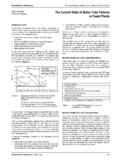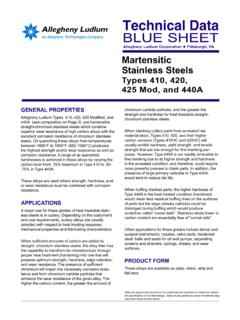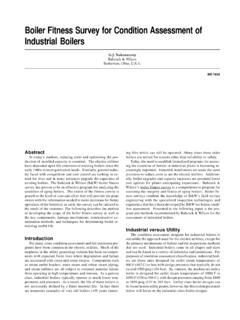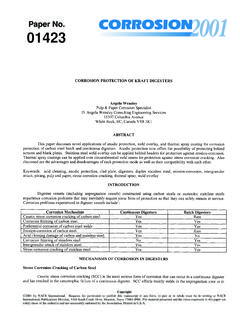Transcription of Technical Data BLUE SHEET - METSERVE
1 Allegheny Ludlum Corporation u Pittsburgh, PAReferenced data are typical and should not be construed as maximum orminimum values for specification or for final design. data on any particularpiece of material may vary from those shown DataBLUE SHEETS tainless SteelsTypes 321, 347 and 348(UNS S32100, S34700 and S34800)GENERAL PROPERTIESA llegheny Ludlum Type 321 (S32100), 347 (S34700),and 348 (S34800) are stabilized stainless steels whichoffer as their main advantage an excellent resistance tointergranular corrosion following exposure to tempera-tures in the chromium carbide precipitation range from800 to 1500 F (427 to 816 C). Type 321 is stabilizedagainst chromium carbide formation by the addition oftitanium.
2 Types 347 and 348 are stabilized by theaddition of columbium and tantalum. Type 348 hasrestricted cobalt and tantalum content for Types 321, 347 and 348 continue to be employedfor prolonged service in the 800 to 1500 F (427 to816 C) temperature range, Type 304L has supplantedthese stabilized grades for applications involving onlywelding or short time heating. (For information on Type304L, consult the Allegheny Ludlum blue SHEET onTypes 302, 304, 304L and 305.)Types 321, 347 and 348 stainless steels are alsoadvantageous for high temperature service because oftheir good mechanical properties. Types 321, 347 and348 stainless steels offer higher creep and stressrupture properties than Type 304 and, particularly, Type304L which might also be considered for exposureswhere sensitization and intergranular corrosion areconcerns.
3 This results in higher elevated temperatureallowable stresses for these stabilized alloys for ASMEB oiler and Pressure Vessel Code applications. TheTypes 321, 347 and 348 alloys have maximum usetemperatures of 1500 F (816 C) for code applicationslike Type 304, whereas T304L is limited to 800 F(426 C).The properties of Type 348 are similar to the propertiesof Type 347, and according to ASTM A240 their chemi-cal compositions are the same except for tantalum andcobalt contents. High carbon versions of all three alloysare available. These grades have UNS designationsS32109, S34709, and COMPOSITIONR epresented by ASTM A240 and ASME SA-240specificationsWeight Percent Maximum UnlessRange is SpecifiedElementType 321 Type 347 Type 348 Carbon* +--10xC min to10xC min to Tantalum** **5x(C+N) * Also H grade with Carbon - ** H grade minimum stabilizer is different formulaReferenced data are typical and should not be construed as maximum orminimum values for specification or for final design.
4 data on any particularpiece of material may vary from those shown SteelTypes 321, 347 and 348 Visit our Website TO CORROSIONG eneral CorrosionTypes 321, 347 and 348 alloys offer similar resistanceto general, overall corrosion as the unstabilized chro-mium nickel Type 304. The Allegheny Ludlum TechnicalData blue SHEET on Type 304 may be consulted for anindication of resistance to corrosive media. Heating forlong periods of time in the chromium carbide precipita-tion range may affect the general resistance of Types321, 347 and 348 in severe corrosive most environments, all three alloys will show similarcorrosion resistance; however, Type 321 in the annealedcondition is somewhat less resistant to general corro-sion in strongly oxidizing environments than annealedType 347.
5 For this reason, Type 347 is preferable foraqueous and other low temperature in the 800 to1500 F (427 to 816 C) tempera-ture range lowers the overall corrosion resistance ofType 321 to a much greater extent than Type 347 and 348 are used primarily in high tempera-ture applications where high resistance to sensitizationis essential, thereby preventing intergranular corrosionat lower CorrosionAllegheny Ludlum Stainless Types 321, 347 and 348have been developed for applications where theunstabilized chromium-nickel steels, such as Type 304,would be susceptible to intergranular the unstabilized chromium-nickel steels are heldin or slowly cooled through the range of 800 to1500 F(427 to 816 C), chromium carbide is precipitated at thegrain boundaries.
6 In the presence of certain stronglycorrosive media, these grain boundaries are preferen-tially attacked, a general weakening of the metalresults, and a complete disintegration may media or weakly corrosive aqueous agents,milk and other dairy products, or atmospheric condi-tions rarely produce intergranular corrosion even whenlarge amounts of precipitated carbides are thin gage material is welded the time in thetemperature range of 800 to 1500 F (427 to 816 C) is soshort that with most corroding media the unstabilizedtypes are generally satisfactory. The extent to whichcarbide precipitation may be harmful depends upon thelength of time the alloy was exposed to 800 to 1500 F(427 to 816 C) and upon the corrosive the longer heating times involved in welding heavygages are not harmful to the unstabilized "L" gradealloys where the carbon content is kept to low amountsof or high resistance of the stabilized Type 321, Type347 and Type 348 stainless steels to sensitization andintergranular corrosion is illustrated by data for the Type321 alloy in the Copper-Copper Sulfate 16% SulfuricAcid Test (ASTM A262, Practice E) below.
7 Mill an-nealed samples were given a sensitizing heat treatmentconsisting of soaking at 1050 F (566 C) for 48 hoursprior to the Corrosion TestLong-Term Sensitization* ResultsASTM A262 Practice E*Annealed 1100 F, 240 hoursThe absence of intergranular attack (IGA) in the Type347 specimens shows that they did not sensitize duringthis thermal exposure. The low corrosion rate exhibitedby the Type 321specimans shows that even though itsuffered some IGA, it was more resistant than Type304L under these conditions. All of these alloys are farsuperior to regular Type 304 stainless steel under theconditions of this general, Types 321, 347 and 348 are used for heavywelded equipment which cannot be annealed and forequipment which is operated between 800 to 1500 F(427 to 816 C) or slowly cooled through this gained in a wide range of service conditionshas provided sufficient data to generally predict thepossibility of intergranular attack in most (ipm)BendRate (mpy) data are typical and should not be construed as maximum orminimum values for specification or for final design.
8 data on any particularpiece of material may vary from those shown data blue SHEETP lease also review our comments under the HEATTREATMENT CORROSION CRACKINGThe Type 321, 347 and 348 austenitic stainless steelsare susceptible to stress corrosion cracking (SCC) inhalides similar to Type 304 stainless steel. This resultsbecause of their similarity in nickel content. Conditionswhich cause SCC are: (1) presence of halide ion(generally chloride), (2) residual tensile stresses, and(3) environmental temperatures in excess of about120 F (49 C). Stresses may result from cold deforma-tion during forming operations, or from thermal cyclesencountered during welding operations. Stress levelsmay be reduced by annealing or stress-relieving heattreatments following cold deformation.
9 The stabilizedTypes 321, 347 and 348 alloys are good choices forservice in the stress relieved condition in environmentswhich might otherwise cause intergranular corrosion forunstabilized Types 321, 347 and 348 alloys are particularlyuseful under conditions which cause polythionic acidstress corrosion of non-stabilized austenitic stainlesssteels, such as Type 304. Exposure of non-stabilizedaustenitic stainless steel to temperatures in the sensi-tizing range will cause the precipitation of chromiumcarbides at grain boundaries. On cooling to roomtemperature in a sulfide-containing environment, thesulfide (often hydrogen sulfide) reacts with moisture andoxygen to form polythionic acids which attack thesensitized grain boundaries.
10 Under conditions ofstress, intergranular cracks form. Polythionic acid SCChas occurred in oil refinery environments where sulfidesare common. The stabilized Types 321, 347 and 348alloys offer a solution to polythionic acids SCC byresisting sensitization during elevated temperatureservice. For optimum resistance, these alloys shouldbe used in the thermally stabilized condition if service-related conditions may result in CorrosionThe resistance of the stabilized Types 321, 347 and 348alloys to pitting and crevice corrosion in the presence ofchloride ion is similar to that of Type 304 or 304 Lstainless steels because of similar chromium , 100 ppm chloride in aqueous environments isconsidered to be the limit for both the unstabilized and42% MagnesiumBase MetalCracked,24-71 hoursChloride, BoilingWeldedCracked24-71 hours33% LithiumBase MetalCrackedWithin 18 hoursChloride.







